It seems impossible that woven strips of leather and hide would have any influence in guiding a creature as powerful as a horse. As ineffectual as it may appear, the hackamore is in fact a very effective means of communication. Although its design seems simple, it is a sophisticated training tool that offers unique and valuable benefits. It is an alternative to the bit for young horses whose mouths are constantly changing and often tender. It makes the transition from the snaffle to the curb bit smoother by developing the balanced movement and self-carriage that a horse will have when he’s finished and in the bridle. It can also help to increase sensitivity and refine performance. Nevertheless, the hackamore is only as good as the hands on the ends of the reins. It can be misused, and it’s not right for every horse and rider. Good results require a rider with a solid foundation in basic horsemanship skills, an obedient horse and understanding of how a hackamore works.
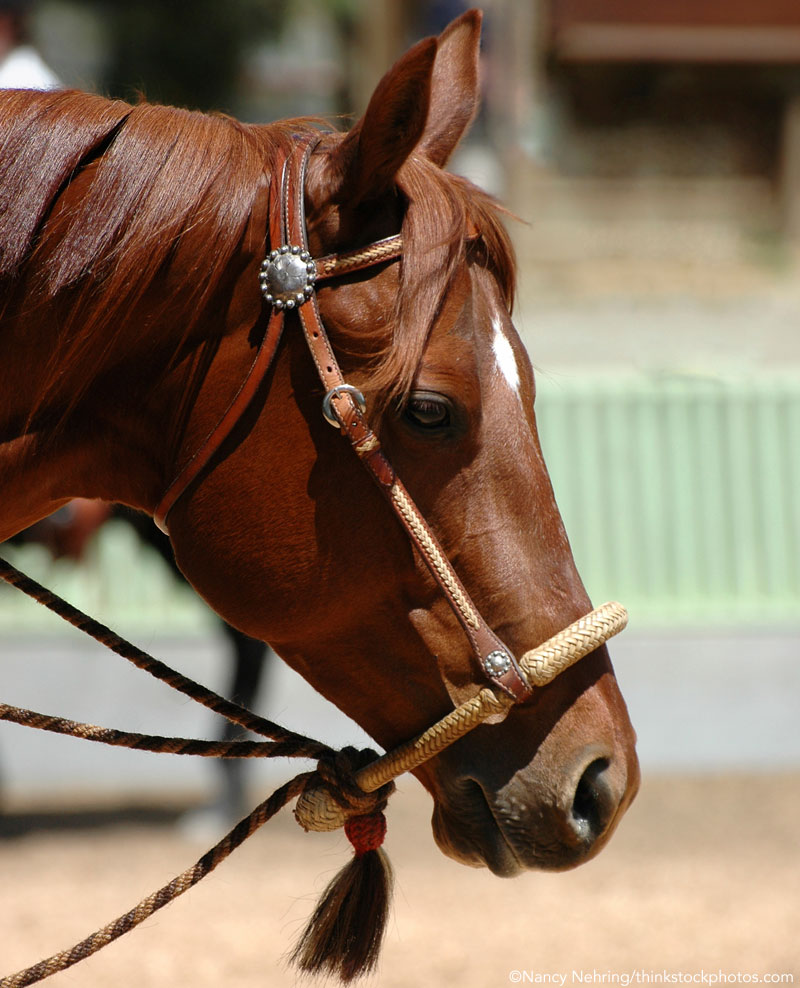
The Equipment
A mecate is a single line of rope, made of horsehair or other material that is approximately 22 feet long. It’s tied above the heel knot and creates a loop that forms the reins and a length of line that’s used as a lead. The mecate can be used to adjust the fit of the bosal, making it tighter or looser against the horse’s face. However, a bosal that is too small can’t be altered, and it shouldn’t be used. It will be uncomfortable for the horse and won’t release properly. Instead, the bosal should fit like an old comfortable hat. It shouldn’t flop loosely nor create pressure against the horse’s face if the reins are slack.
When the bosal is in the proper position, it will rest on the nasal bump that lies just below the midpoint of the eyes and nostrils. It’s fine for the cheeks of the bosal to be in contact with the face as long as they aren’t creating pressure. When the bosal is hanging loose, there should not be any contact under the horse’s jaw, and there should be a two-finger gap above the last wrap of the mecate.
How it Works
The hackamore applies pressure to the sensitive areas around the horse’s nose, the sides of the face and the underside of the jaw by means of a subtle side-to-side rocking motion. Its design provides very little lateral control because both reins of the hackamore connect at exactly the same location, continuous and unbroken. The placement of the reins and the way the bosal moves on his face make it difficult for the horse to differentiate clumsy cues from a rider.
Before a horse is ready to embark upon his education in the hackamore, he needs to be obedient, disciplined and have a solid foundation under saddle. The snaffle bit is an excellent choice for building the basics of forward motion, flexibility and balance, and preparing a horse for the next stage of training, whether he goes straight into the bridle or spends some time in the hackamore. Once the horse is in the hackamore, the training wheels are off, and he can no longer rely on the rider’s hands for support.
The rider needs a sophisticated touch to clearly communicate. Trying to muscle or intimidate a horse with the bosal will blow his confidence and instill resistant behavior, which can lead to a runaway situation. Riding in a hackamore is about finesse not force, and once a horse learns to brace against the rider’s hands, retraining him to yield properly may be difficult if not impossible.
The Rules
To make the hackamore experience positive for your horse, there are rules that need to be followed:
- Rule number one: Never pull steadily. Remember that no matter how hard you pull, your horse can pull harder. In the end, you will lose the battle … and eventually the war. You’ll create a major setback in your horse’s training, and you’ll probably have to shelve the hackamore.
- Rule number two: Never use equal pressure on both reins simultaneously. Since the reins are joined together, using them evenly locks the bosal against the horse’s face. Consequently, the horse will lock up against the bosal. Using each rein independently so that there is some degree of side-to-side motion will help keep the horse light in the rider’s hands instead of leaning against the reins.
- Rule number three: When your horse responds correctly to the hackamore, reward him. If you want your horse to repeat a behavior, the best way to motivate him to do it again is by releasing the pressure completely when he gives in to the cue. Even a “try” should buy your horse some degree of relief.
Getting Started
Introduce your horse to the hackamore in stages, first getting him accustomed to it on the ground. Tie the mecate reins and lead to the saddle (the best way to do this is to loop the reins over the saddle horn—or bring them through the pommel and then over the horn if they are long enough—then tie the lead over the reins on the horn in a way that keeps everything secure), turn your horse loose in a round pen, and ask him to walk, trot and lope both ways. The reins should be loose enough that your horse feels the natural rocking motion of the bosal, but short enough to prevent him from dropping his nose below his knees and possibly stepping on the reins or catching a leg. Initially, he may be bothered by the hackamore’s motion on his face, but after a few laps he’ll learn how to steady his head and carry the bosal comfortably—the first step he’ll take to developing self-carriage.
Yielding at the Poll
Once your horse is relaxed and moving comfortably at every gait, untie the lead. You’ll use it to familiarize your horse with the same cues you’ll give from the saddle. The following exercises help the horse understand how to respond to the hackamore’s pressure. First teach him to yield laterally at the poll for the directional control of his face you’ll need for balanced turns. Stand at his left side, near his shoulder, with your left hand on the lead line about 6 inches from the heel knot. Take the slack out of the line by bringing it out to the side at a slightly upward angle. With your fingertips resting against the line, press or tap rhythmically until your horse turns his head to the side. If he moves his feet toward you instead of turning his head, tell him “whoa” and try again. You can place your free hand on his shoulder to discourage him from moving. If your horse doesn’t respond, don’t pull harder. Just give him as much time as he needs to figure out what you’re asking of him, which is to turn his head to the side by flexing at the poll without moving his feet. As soon as he responds correctly, release the pressure and praise him.
The correct response is when your horse turns his head by flexing at the poll without raising or lowering his neck. Give your horse as much time as he needs to figure out what to do. As soon as he gives the correct response, release all the pressure on the line and praise him.
Next, ask him to bend his entire neck toward you to encourage him to be supple throughout the length of his body. Step back even with his rib cage, about a step away, to give him more room. Hold your hand about 12 inches from the heel knot, and take the slack out of the line by drawing your hand toward your body as you press or tug softly on the bosal with your fingers. It’s OK if your horse starts to walk around you, as long as he’s bending his head and neck to the inside, because it teaches him how to flex through his spine in response to the pressure on his nose. Allow him to continue to walk until he comes to a stop while his neck is still turned, and then release the pressure. Repeat this exercise a few times in both directions until your horse can both walk and stand comfortably with a bend in his neck.
Once your horse understands the basics on the ground, it’s time to climb aboard and reinforce the same exercises under saddle. Secure your lead to the saddle horn with enough length so that it doesn’t interfere with your horse’s ability to turn his head in either direction and allows the complete release of the bosal, but not so loose that he can put his head onto the ground or put a leg through the line.
Under saddle, you might notice that your horse is twisting his head and neck instead of keeping his face vertical if he is confused about the cues originating from below his chin. Keeping your hands wide will help to resolve this problem. When asking for either a bend or for your horse to shift his weight over his hindquarters, open your inside rein first to tip his head in the direction of travel before drawing your hand back to shift his weight rearward or position his body to follow the arc of a turn or circle. Because of the configuration of the bosal, keeping your horse supple by asking him to yield laterally will lessen the chance of him being resistant or bracing against your hands.
Moving Forward
When you’re ready to move your horse forward under saddle, avoid straight lines until he is supple in the face and able to maintain the proper bend on a circle. Master the bend at the walk before moving on to the jog, and so on. You’ll continue to use the rocking movement with your fingertips, or you can add a snap of your wrist if you need to make your cues more obvious. No matter the gait, the motion of your hands should always be rhythmic and follow your horse’s natural cadence.
Carry your hands even with or slightly ahead of the saddle horn, and lead your horse into turns and circles by moving your inside hand slightly forward and away from your horse’s neck. Use an active inside leg to encourage your horse to lift his shoulder and bend through his rib cage and carry himself in a round frame. Hold your outside rein away from your horse’s neck—give that rein an occasional sideways bump, as needed, to remind your horse to travel in balance down the center of your reins. As his training progresses, your horse will develop self-carriage and respond to subtle changes in the position of the bosal.
The bosal is a wonderful tool for furthering a horse’s education and refining his performance. When used appropriately it promotes self-carriage and increases sensitivity and responsiveness, qualities that are integral to developing a horse’s athletic ability and helping him reach his full potential.
Read on to learn about hackamore styles >>
Dale Rudin trains western performance and all-around horses at Sycamore Trails Stables in Southern California and is HI’s regular western Training Talk columnist.

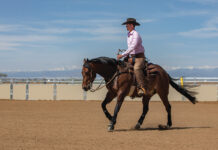
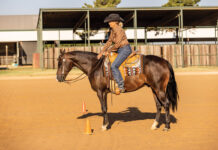
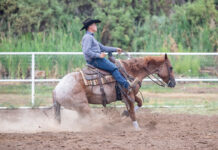

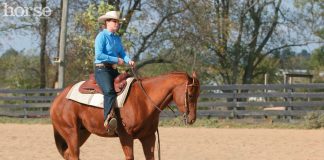

good article. I only ride my horses in a hackamore
Not sure if that is for me and my horse…
Good article. I ride in a bitless bridle and I know using that I can ride my horse in a Basel. In my mind they are a very usefull tool for teaching. If I didnt have my bridle I would buy one of these.
I will give this a shot some time!
Thanks for putting the spotlight on this wonderful communication tool.
Good article on using a hackamore with a bosal. It reminds me of the books that were written by the late Ed Connell regarding hackamore training. He learned from the old Spanish cowboys in the central valley area of California. Using a hackamore teaches the rider to use gentle hands with the horse. And in return you get a very responsive horse using a gentle touch of the reins.
What about horses ridden western and neck reined? I use a hackamore with my horse and neckrein. You cannot avoid putting equal pressure on the nose. He responds just fine. Others do the same thing in our barnn
OK but you forgot the fiador. Most people nowdays do but it is an integral part of the hackamore set.